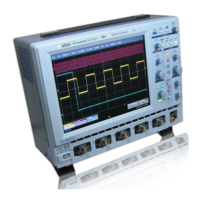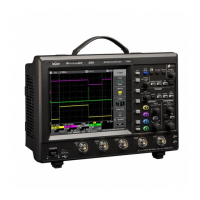Operator's Manual
72 WS-OM-E Rev B
from the timebase).
5. Choose a line style for your trace: solid Line
or Points .
Persistence Setup
The analog Persistence feature helps you display your waveform and reveal its idiosyncrasies or
anomalies for a repetitive signal. Use Persistence to accumulate on-screen points from many
acquisitions to see your signal change over time. The instrument's persistence modes show the
most frequent signal path "three-dimensionally" in intensities of the same color, or graded in a
spectrum of colors.
You can show persistence for up to eight inputs: any channel or memory location (M1 to M4) plus
the math function trace.
Saturation Level
The Persistence display is generated by repeated sampling of the amplitudes of events over time,
and the accumulation of the sampled data into "3-dimensional" display maps. These maps create
an analog-style display. User-definable persistence duration can be used to view how the maps
evolve proportionally over time. Statistical integrity is preserved because the duration (decay) is
proportional to the persistence population for each amplitude or time combination in the data. In
addition, the instrument gives you post-acquisition saturation control for a more detailed display.
When you select Analog mode
from the Persistence dialog, a single color is used. As a
persistence data map develops, different intensities of that color are assigned to the range
between a minimum and a maximum population. The maximum population automatically gets the
highest intensity, the minimum population gets the lowest intensity, and intermediate populations
get intensities in between these extremes.
The information in the lower populations (for example, down at the noise level) could be of
greater interest to you than the rest. The Analog persistence view highlights the distribution of
data so that you can examine it in detail.
You can select a saturation level as a percentage of the maximum population. All populations
above the saturation population are then assigned the highest color intensity: that is, they are
saturated. At the same time, all populations below the saturation level are assigned the remaining
intensities. Data populations are dynamically updated as data from new acquisitions is
accumulated.

